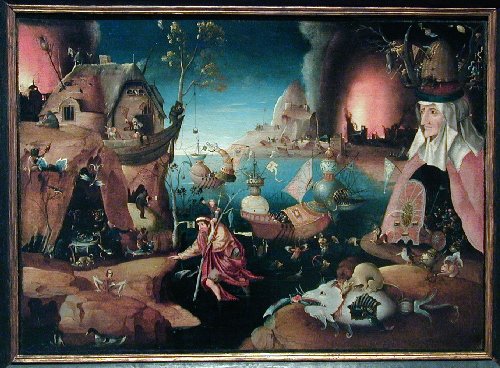Bosch's Demons
Today, we take a new look at some old pictures. The University of Houston's College of Engineering presents this series about the machines that make our civilization run, and the people whose ingenuity created them.
Who hasn't looked at Hieronymus Bosch's pictures with the crawling sensation that he's been shown a window into Hell? Bosch painted his terrible visions of sin and human folly between 1475 and 1516. We see the demons, monsters, and fragments of beings that populate his paintings. We wonder what drove the man. Art historian Laurinda Dixon looks at his St. Anthony triptych with a growing understanding of his real aims.
We do know that Bosch drew on the folklore of his day -- that 15th-century viewers recognized the demons of their own mythology in his work. But Dixon discovers something more. At least in this St. Anthony painting, Bosch is transmuting the pharmaceutical and medical technology of his day into metaphor.
The painting shows us stages of St. Anthony's life, yet everywhere in its mad landscape we see elements that make no sense to us: an amputated and mummified human foot, a strange figure -- half human, half vegetable, an egg-shaped structure belching smoke and flame. What can be going on!
Dixon's answer is that during Bosch's life the disease called St. Anthony's Fire was rampant. Today we know that St. Anthony's Fire was caused by a form of grain ergot. The symptoms included fiery pain and gangrene that required amputations. Furthermore, since ergot baked in bread dough forms LSD, the disease also led to terrifying hallucinations. Indeed, the witch-hangings that went on in Salem, Massachusetts, a century later occurred during an outbreak of rye ergot. Those poor ladies, like the imagined viewers of Bosch's triptych, were probably just high on acid.
So we dig deeper and find that amputated limbs were saved during Bosch's time so they might be rejoined to their owners at the last judgment. The odd vegetable creature is painted in the shape of a mandrake root. Mandrake was the herb used to stanch the feverish pains of St. Anthony's Fire. The egg-shaped building is exactly the shape of an apothecary's retort -- the distillery used to reduce medicinal herbs.
Element by element Dixon walks us through Bosch's hallucinogenic scene. By the time she's done, we don't see the ravings of a madman at all. We see instead a wonderfully imaginative, but nevertheless realistic, documentary. We see 15th-century medical technology spelled out in metaphorical terms.
Bosch does what today's technical writers too often fail to do. When he shows us the means for coping with human misery, he shows us the nature and texture of the misery as well. He binds a technology to the human needs it serves.
I'm John Lienhard, at the University of Houston, where we're interested in the way inventive minds work.
(Theme music)
Dixon, L.S., Bosch's 'St. Anthony Triptych' -- An Apothecary's Apotheosis. Art Journal, Vol. 44, No. 2, 1984, pp.119-131.
For the tryptich itself see the website, http://en.wikipedia.org/wiki/The_Temptation_of_St._Anthony and, for other Bosch paintings, see: http://www.sai.msu.su/cjackson/bosch/
For more on rye ergot, see Episode 1037.

St. Christopher Carrying the Christ Child through a Sinful World, Bosch, c1520